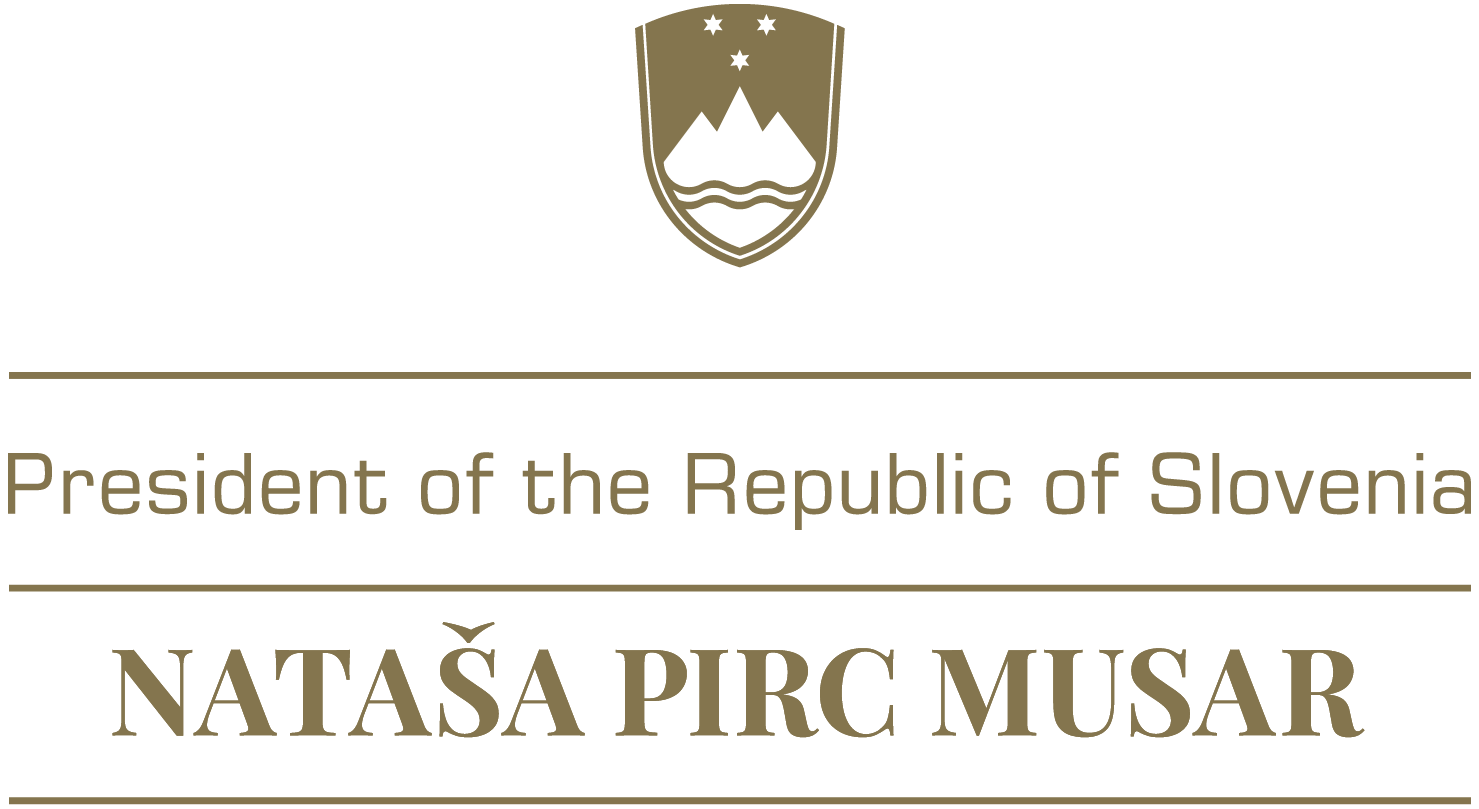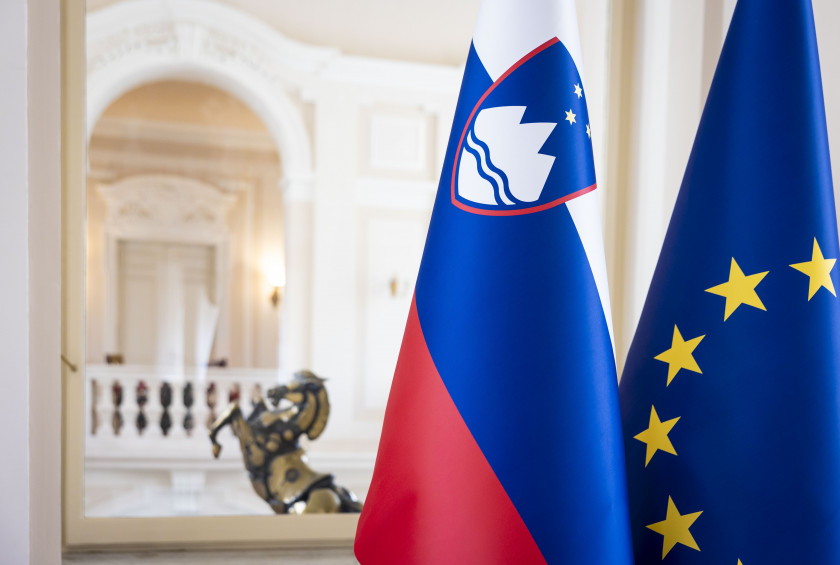Halls of the Presidential palace
The main protocol entrance, one of five entrances to the building, is on Prešeren Street. The entrance is guarded by two seated statues symbolising law (on the right) and power (on the left). They were made by Josef Beyer, a sculptor from Vienna.
On special occasions and protocol events at the highest level, a guard of honour of members of the Slovenian Guards Unit is stationed at the main protocol entrance.
The most beautiful and central rooms are located on the first floor, which is accessed by the central staircase. The vault of the grand staircase is supported by two mighty statues of Atlas by Austrian sculptor Theodor Friedl and decorated with brass candelabras by Leopold Tratnik.
A bronze statue of a rearing Lipizzaner has stood at the top of the central staircase leading from the entrance on Prešeren Street to the Crystal Hall for several years. It was made by renowned Slovenian sculptor Janez Boljka. In 2023, Slovenia, like other EU countries, will provide artwork to decorate the seat of the Court of Justice of the European Union in Luxembourg. In cooperation with the National Gallery, we decided that a twin of this statue would perfectly symbolise Slovenia’s natural and cultural heritage. But no more than a few casts have been made. Aleš Musar discovered that the NLB bank had one in its art collection. On his initiative, NLB lent the statue on a long-term basis to the National Gallery, which in turn lent it to the Court of Justice of the European Union in Luxembourg. The twin of the statue from the Presidential Palace began its journey to Luxembourg in June 2023, on the very day that the Lipica stud farm was awarded a certificate of inscription on UNESCO’s Representative List of the Intangible Cultural Heritage of Humanity. The official handover is planned for the autumn, when the President of the Republic of Slovenia, Nataša Pirc Musar, visits the EU Court of Justice in Luxembourg.
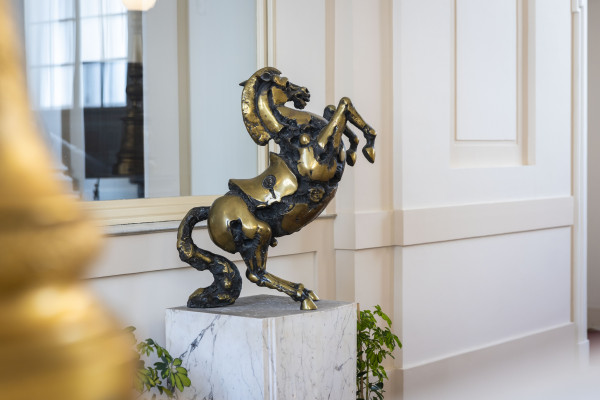
The central staircase leads to the Grand Crystal Hall, which is at the heart of the building. The largest hall of the Palace is one of the most beautiful in Slovenia. It is adorned with two magnificent chandeliers made from Murano glass, hence the name Crystal Hall. The hall was originally a chapel, but after the Second World War it was converted into an assembly hall for government sessions. In terms of architectural design and furnishings, it is one of the most beautiful of its kind in the country.
Today, the Grand Crystal Hall is the venue for state events of the highest level, such as receptions for foreign dignitaries, the presentation of state decorations and the conferring of credentials on new ambassadors. It is also used as the venue for gala dinners and other receptions, roundtables, consultations, press conferences, and other protocol events.
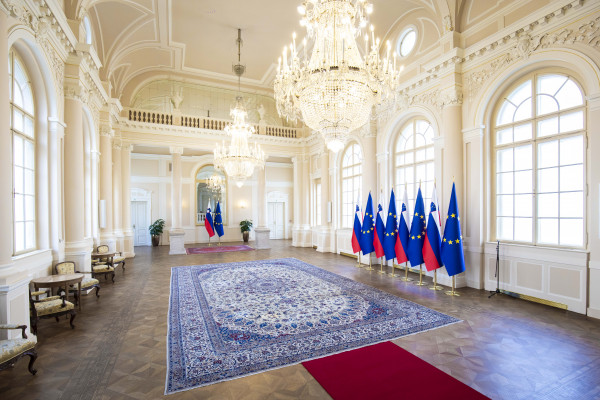
Opposite the Grand Crystal Hall is a large meeting room, simply known as Room 70. Once the office of the head of the authority in power, it is now used for working talks between a large number of participants on various occasions, such as bilateral talks between the delegation of the Republic of Slovenia and the delegation of a foreign country whose head of state is visiting Slovenia.
In front of Room 70, there is a perhaps somewhat unexpected object: a Tomos motorcycle. It is one of only five prototypes from 1976 and is entirely the result of Slovenian know-how and design. It was lent by the Technical Museum of Slovenia. Our technical heritage is also an important part of our history, and we can be truly proud of it. Did you know that one of the pioneers of motorcycle manufacturing was Janez Puh from the region of Slovenske Gorice? Although the Puch factory is now in Austria, its founder was Slovenian. If you know of an example of Puh’s pre-World War I motorcycle, please let the Technical Museum know: they are still looking for one themselves. You must have heard, however, that the President is herself a biker.
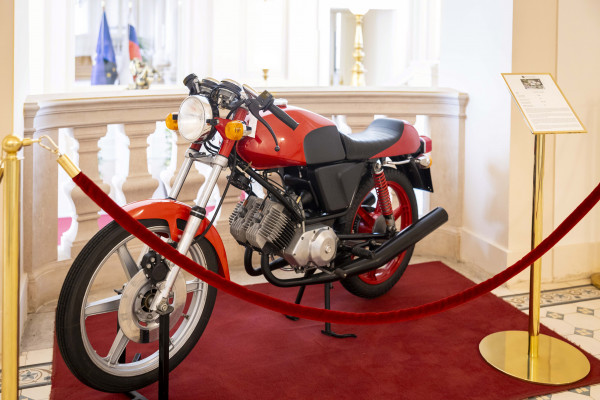
The Golden Room is one of the smaller rooms, but the gold stuccoes that give it its name make it one of the most iconic rooms in the Presidential Palace. The Golden Room is where the President of the Republic holds tête-à-tête meetings with foreign heads of state or government, meets with the recipients of state decorations before the award ceremony or the newly appointed ambassadors of foreign countries following the presentation of credentials, and talks to other distinguished guests.
The Office of the President of the Republic of Slovenia is located on the first floor of the tower, which connects the northern and western parts of the Palace and is pentagonal in shape. All the previous Presidents of the Republic have had their offices in this room, and it is interesting to note that it used to be a smoking room.
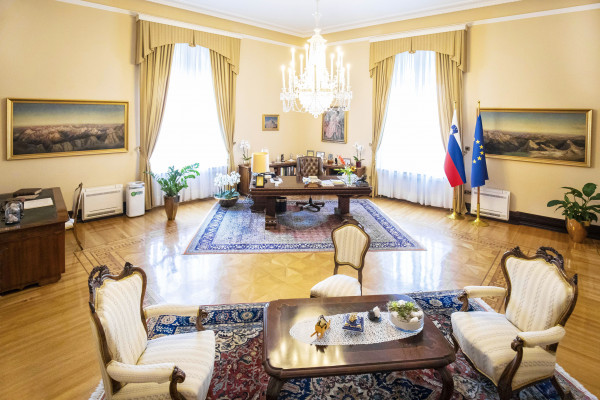
All the paintings in the Office have been selected by the President, with the assistance of the Director of the National Gallery, Barbara Jaki. Opposite the President’s desk is a large portrait of Empress Elizabeth from the time of her youth, painted by Mihael Stroj, one of the leading Slovenian painters of the 19th century. When the foundation stone of the Presidential Palace was laid and the Palace received its operating permit, Empress Sissi was still on the throne. To her left and right are two other strong women, also painted by Mihael Stroj. On the left is the biblical Judith, on the right a Venetian woman. They are copies of works by other painters, which was common practice in the 19th century. The symbolism is certainly recognisable: on the right is a woman with a book, on the left a woman with a sword.
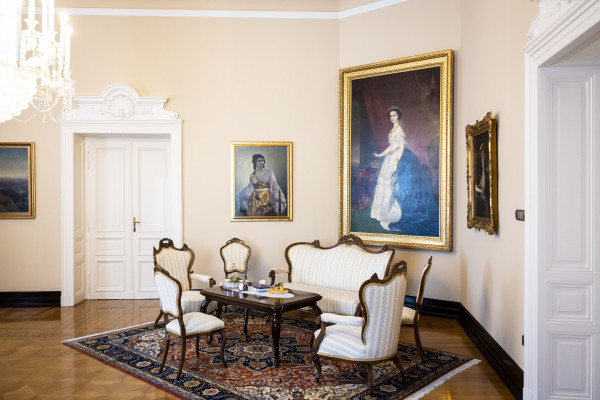
In two corners of the room there are four large paintings, which together make up a panorama from the top of Mount Triglav. It was painted in 1868 by Markus Pernhart, a well-known landscape painter who was particularly famous for his mountain panoramas. The one from the top of the hill Šmarna Gora can be seen in the National Gallery, while the one from Slovenia’s highest peak was lent to the Presidential Palace by the National Museum of Slovenia. The orientation of the paintings is perfect. The view to the north (towards the Cankarjev Dom cultural centre) shows the view from the top of Triglav to the north as it was in the painter’s time. The Triglav Glacier, or the Green Snow, depicted on the painting is much bigger than what we can see today due to climate change.
Behind the President’s desk is a small painting of the top of Triglav, also by Markus Pernhart, and on the other wall is another portrait of a woman by Slovenian impressionist Matej Sternen, which has recently returned from an exhibition at the National Gallery.
On the President’s desk below the two paintings, her work items are accompanied by quite a number of owls.
On the corner of the desk is a bronze statue of an owl created, like the Lipizzaner on the staircase, by Janez Boljka. The statue awaited the President on her desk as a family gift when she assumed the presidency on 23 December 2023.
In the corner of the Office is a very special desk loaned to the Presidential Palace by Mrs Jana Valenčič. It is the writing desk of Baron Žiga Zois, who was a leading enlightener, entrepreneur, industrialist and supporter of Slovenian science and arts more than 200 years ago.
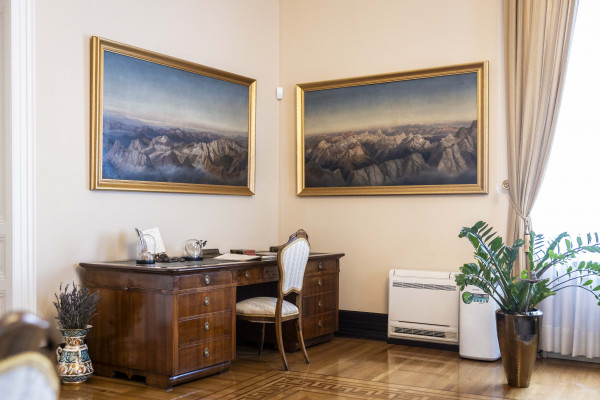
On the desk, each under its glass bell, there are two specimens from the original Zois collection now kept by the Museum of National History of Slovenia. Baron Zois held both of them in his hands! There are Slovenian quartz crystals under one bell and an ammonite fossil under the other; the latter was brought back from the Triglav Lakes Valley by an expedition funded by Zois, led by count and naturalist Hohenwart and attended by poet Valentin Vodnik. On the stand is a biography of Žiga Zois with a portrait of the Baron, published a year after his death. Underneath are a few samples of limonite, the iron ore that was the foundation of Zois’ ironworks business and thus his fortune.
The open book is an important work by Jernej Kopitar, who was sent by Zois to study in Vienna. It is the 1838 book Glagolita Clozianus, in which the Freising Manuscripts, the earliest document in the Slovenian language, were first published. It is open on that page.
The book with the colourful cover is Plantae Alpinae Carniolicae, a description of the plants of Carniola by Baltazar Hacquet, a French naturalist from the Zois circle. In autumn 2023, it will be accompanied by a specimen of Alpine plants prepared by the Julijana Alpine Botanical Garden, which is also part of the Museum of National History.
Two smaller books date from 1802 and describe equipment for chemical laboratories. A true mystery is hidden in the first of these: the owner wrote that he had received the book on 4 March of an unknown year from Baron Žiga Zois. The large book is an 1818 account of an English traveller’s journey through Hungary, a gift from the Hungarian President’s husband to Aleš Musar. All the other books on the desk are from the President’s family library as well.
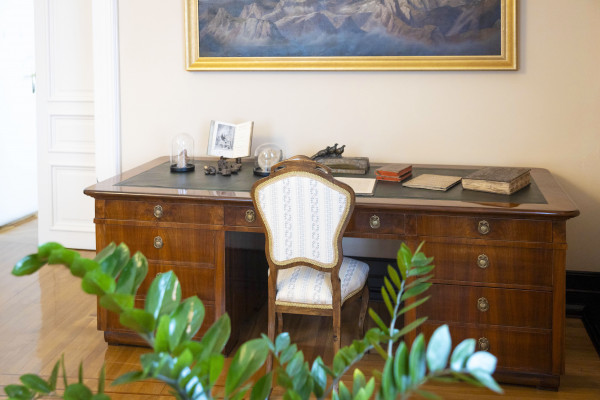
The desk is also adorned with an inkwell and a letter opener made by the Carinthian Frideric Gornik, who made a name for himself in Vienna 150 years ago as a designer of small metal objects, from statuettes to table sets.
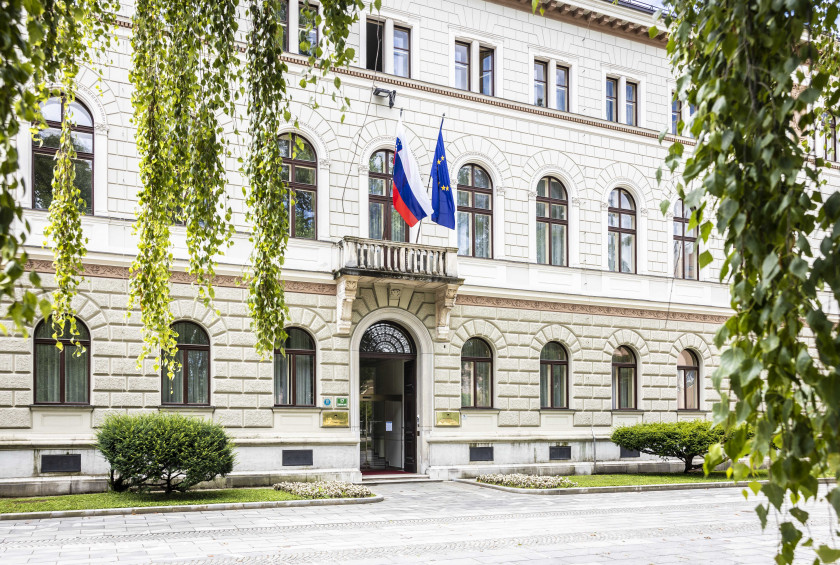
Entrance
Statue of Atlas by Austrian sculptor Theodor Friedl
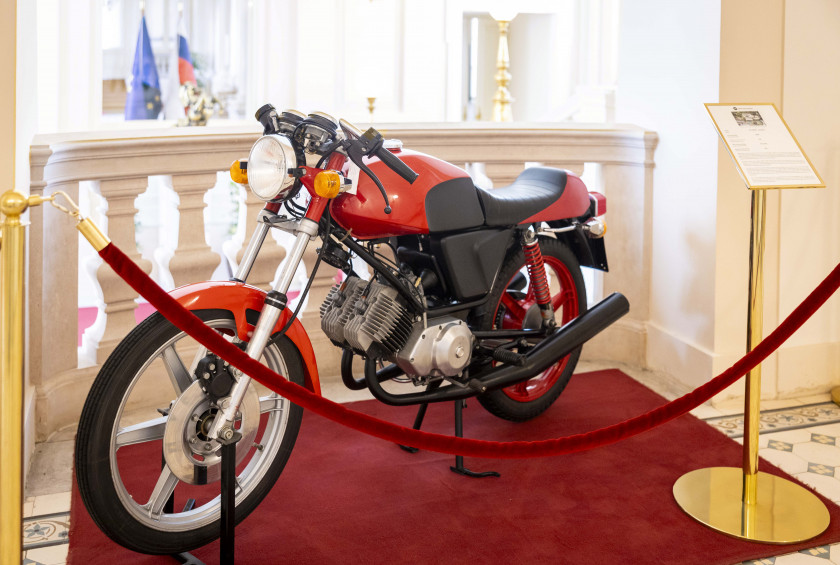
A Tomos motorcycle - one of only five prototypes from 1976.
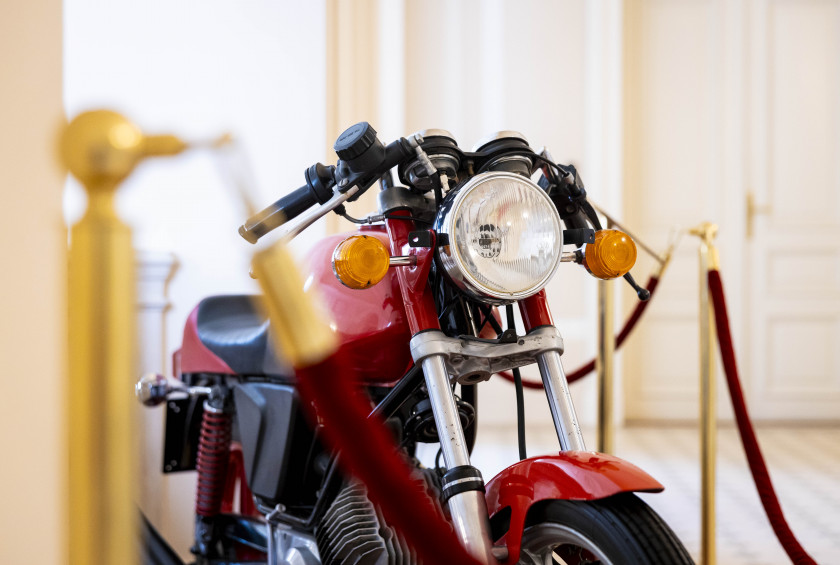
A Tomos motorcycle - one of only five prototypes from 1976.
The large meeting room - Room 70
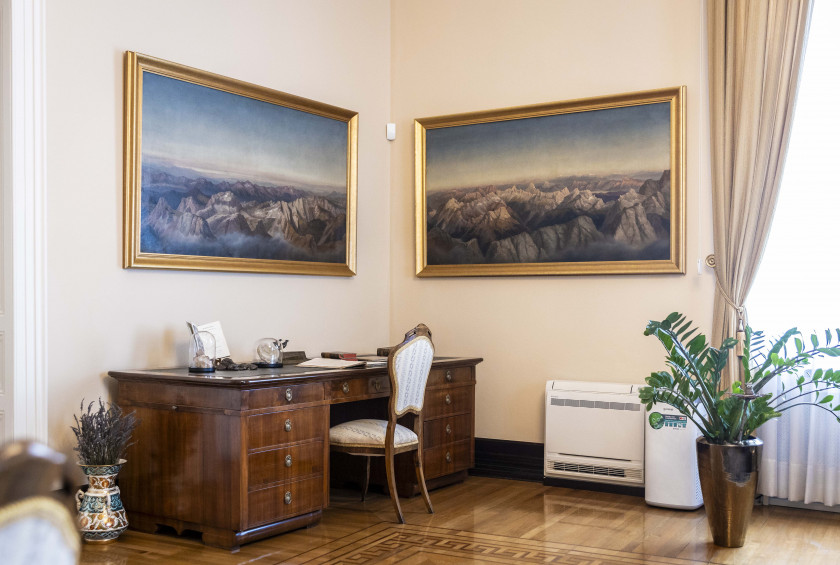
The writing desk of Baron Žiga Zois in the Office of the President.
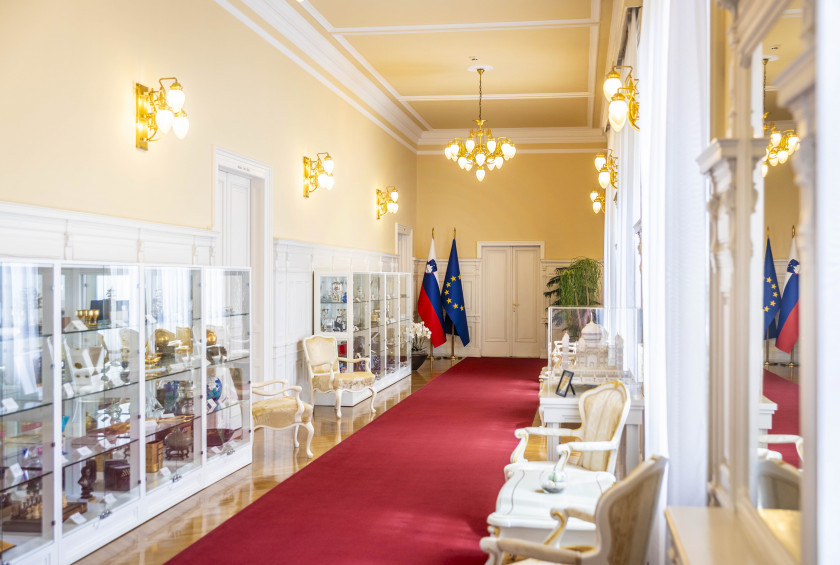
The central corridor
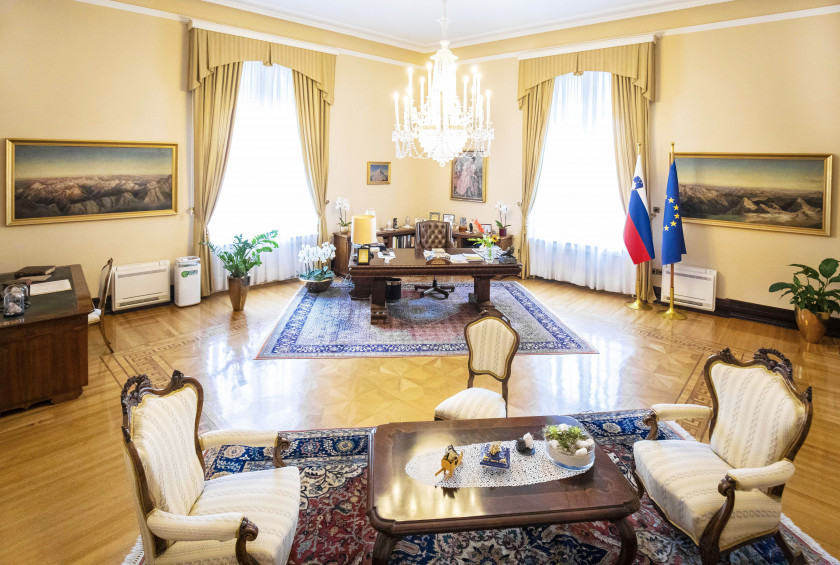
The Office of the President of the Republic of Slovenia
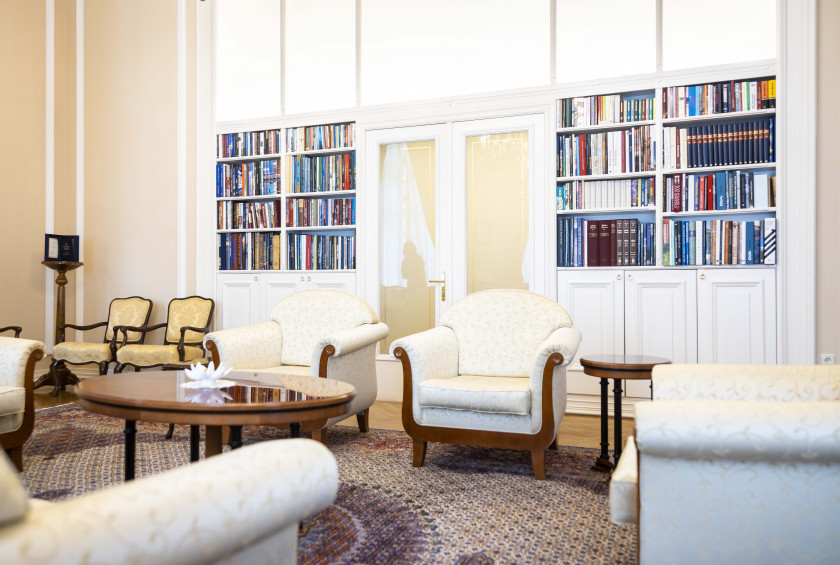
The Ivan Oman Hall
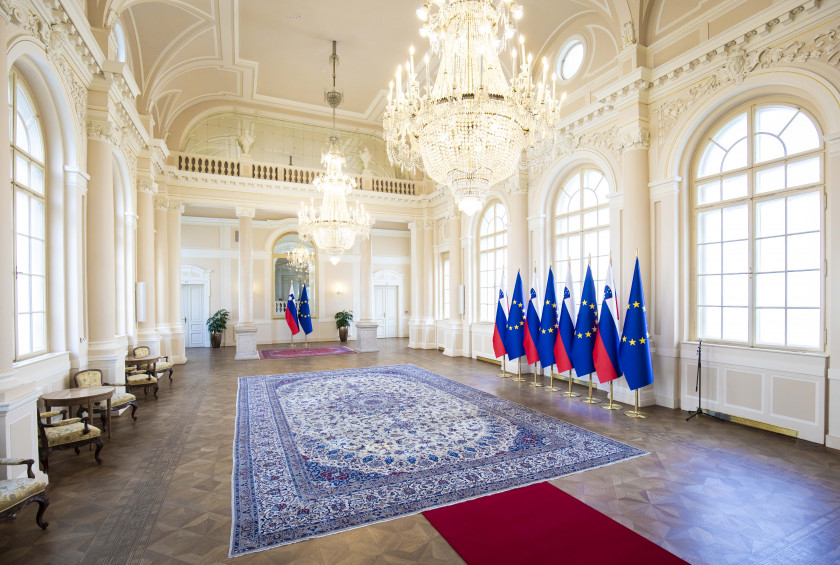
The Grand Crystal Hall
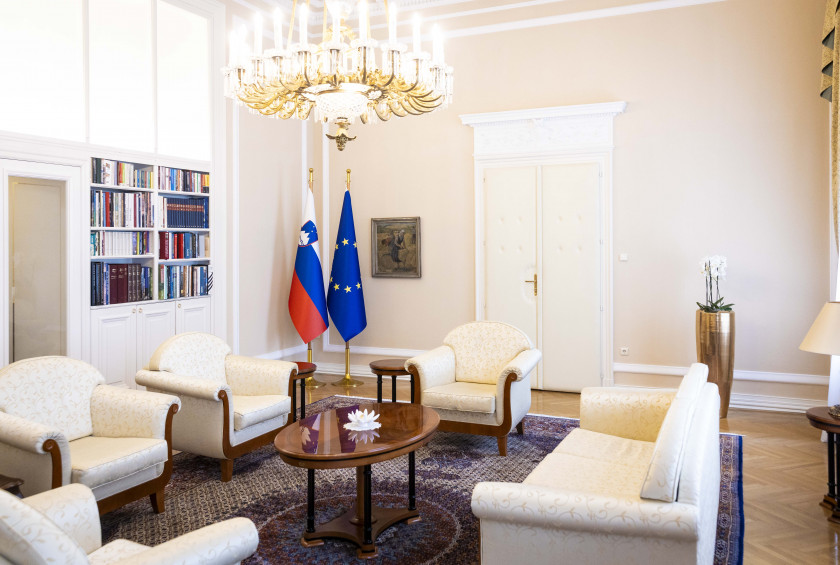
Ivan Oman Hall
The central staircase
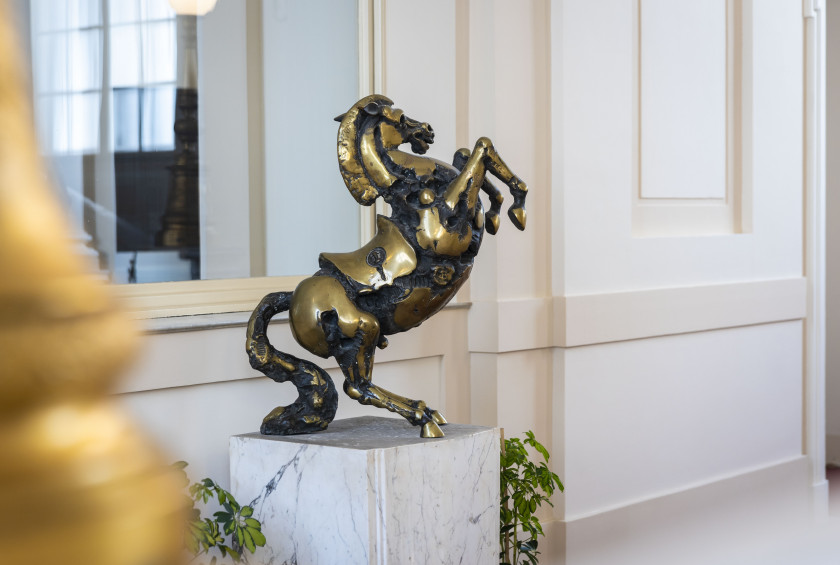
A bronze statue of a rearing Lipizzaner by Janez Boljka.
The Golden Room
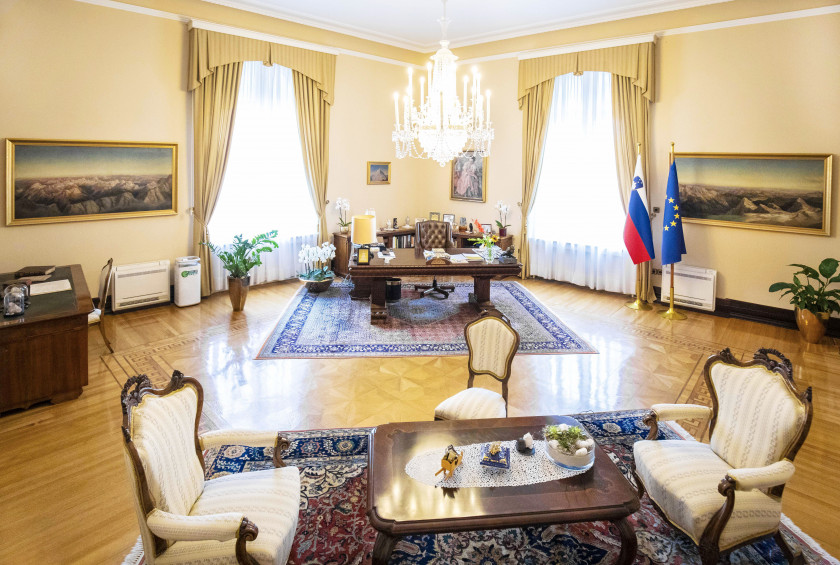
The Office of the President of the Republic of Slovenia
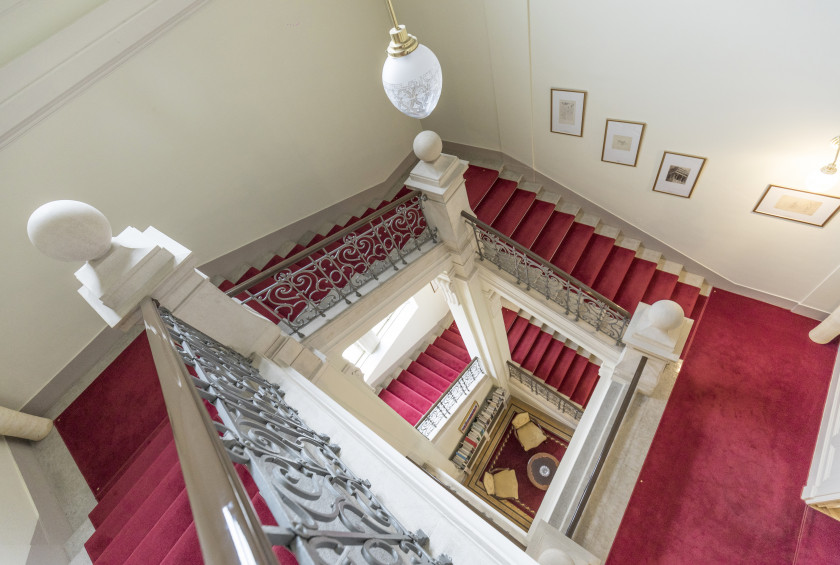
Inner staircase
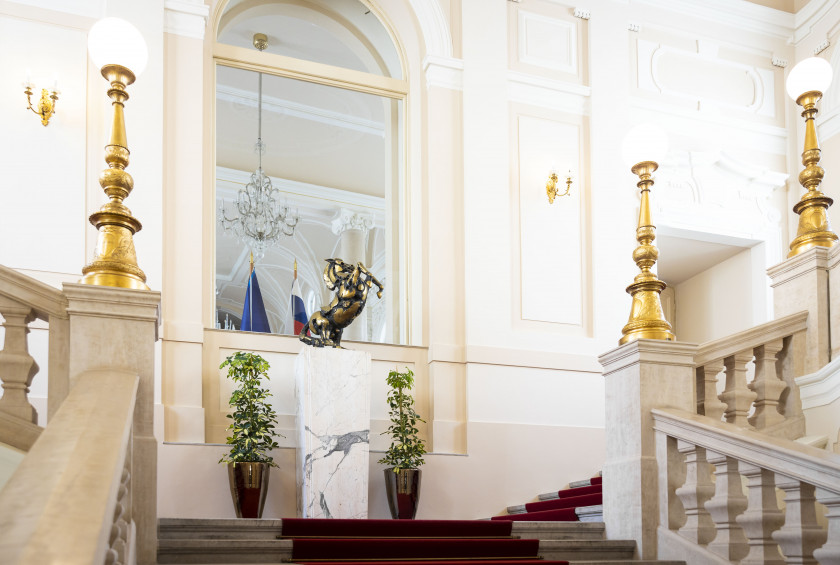
A bronze statue of a rearing Lipizzaner at the top of the central staircase.
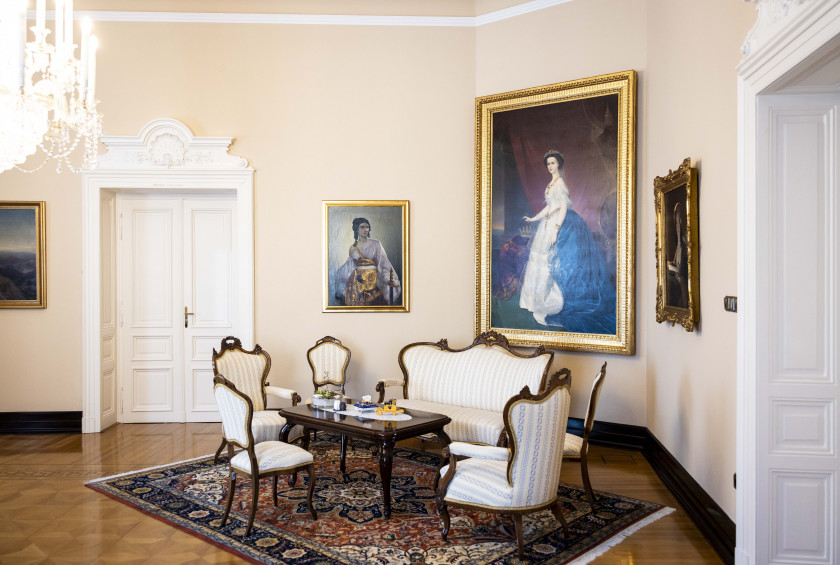
The Office of the President
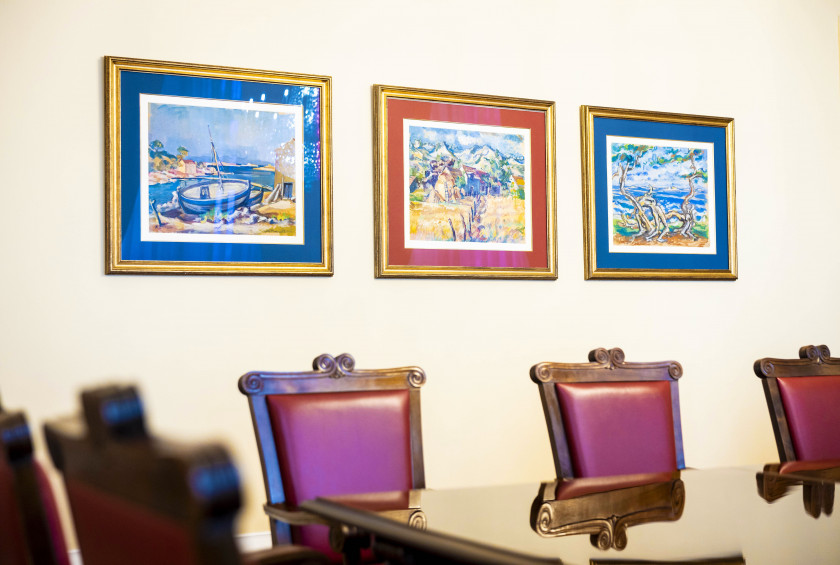
Jože Pučnik Hall
The main protocol entrance
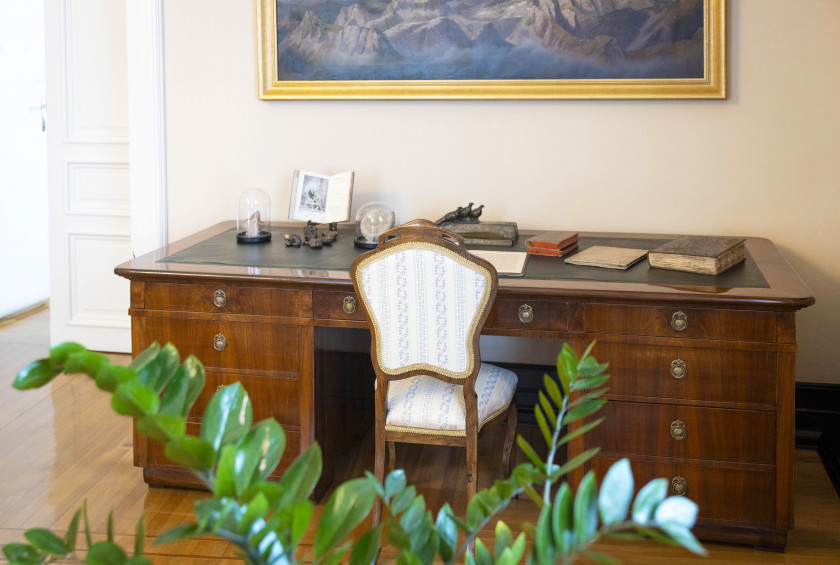
The writing desk of Baron Žiga Zois in the Office of the President.
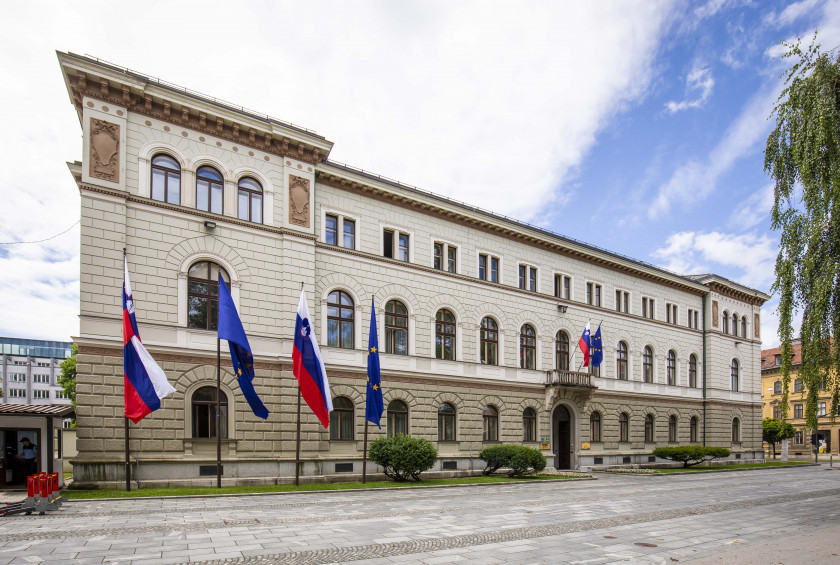
Presidential Palace
Jože Pučnik hall
The central corridor of the Office of the President of the Republic of Slovenia runs along the length of the President's Reception Office, France Bučar Hall and the Golden Room, where a selection of protocol gifts are displayed.
The President’s Office has four halls named after the founding fathers of the Slovenian state:
The France Bučar Hall is one of the rooms used for informal meetings of small groups.
The Ivan Oman Hall, or Reception Hall, is used for meetings with small delegations or for other discussions, such as with representatives of institutions and political parties. There is also a small library in the hall.
Working discussions with smaller delegations are held in the Jože Pučnik Hall.
The Janez Drnovšek Hall is the office of the Chief of Staff to the President of the Republic, Mrs Ula Tomaduz.
